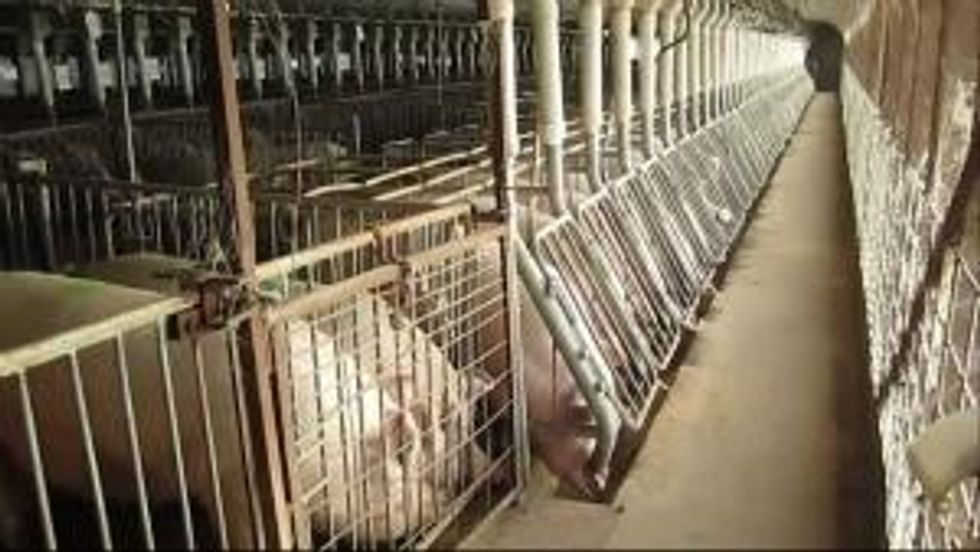The National Pork Producers Council (NPPC) summed up its anti-scientific and anti-animal views when, in attempting to defend the industry's confinement of mother pigs in cages so small the animals can't even turn around, NPPC communications director Dave Warner told the National Journal, "So our animals can't turn around for the 2.5 years that they are in the stalls producing piglets. I don't know who asked the sow if she wanted to turn around..."
When your own communications director makes a remark like that, you have an industry in crisis. I've contacted Mr. Warner three times asking for any scientific evidence he has that he believes justifies cramming pregnant pigs into crates. He hasn't replied, because he has no reply; the science is in, and it all points in one direction: Gestation crates are so cruel that pig "farmers" could be locked in jail on felony cruelty charges if they abused dogs or cats so egregiously.
What are gestation crates?
More than 80 percent of the United States' 5.5 million breeding pigs are crammed into 2 foot by 7 foot crates, unable to engage in many of their most important natural behaviors. They're never able to turn around or even lie down comfortably--day and night, for their entire lives.
The Scientific Consensus
The scientific consensus (nicely summarized here by the Humane Society of the United States) extensively documents that when pigs are immobilized in crates, they develop severe mental disorders from frustration and boredom, their muscles and bones waste away, and more.
Because the science is so clear, every legitimate animal welfare group on the planet condemns gestation crates, including groups that run meat certification programs, like The Animal Welfare Institute and the ASPCA. And it's not only animal protection organizations that condemn crates: Nine U.S. states have outlawed gestation crates, and the crates are illegal across Europe.
The Pew Commission on Industrial Farm Animal Production (which included the Johns Hopkins Bloomberg School of Public Health, former Kansas Governor John Carlin, former U.S. Agriculture Secretary Dan Glickman, farmers, ranchers, and veterinarians) spent more than two years reviewing the science. The Commission's concluded that gestation crates "constitute inhumane treatment" and should be eliminated. Here's why:
Crates cause physical suffering
Lifelong immobility causes pigs' muscles and bones to waste away, so that walking becomes excruciating, and even standing up becomes painful. Because the animals are rubbing against their bars and lying in their own excrement all day and night, they suffer painful ammonia burns on their skin, and their lungs become raw from breathing the putrid air. The animals are constantly starving because they are fed about half of what they would normally consume. Due to lack of exercise, they don't consume enough water. As a result, many sows suffer from urinary tract infections (UTIs). One study estimates that half of sow mortality comes from UTIs. All of these facts are detailed and supported with scientific references in HSUS's report.
Crates cause psychological suffering
Dr. Jane Goodall explains that "farm animals feel pleasure and sadness, excitement and resentment, depression, fear, and pain. They are far more aware and intelligent than we ever imagined ... they are individuals in their own right." Pigs, specifically, have cognitive and emotional capacities that are beyond those of dogs; in some areas, they outperform even chimpanzees. So of course they suffer mental and emotional anguish when they're unable to move for almost their entire lives.
In Animals in Translation, meat industry consultant Dr. Temple Grandin (a longtime advisor to the American Meat Institute and USDA) states unequivocally what the science proves--that pigs and other animals have the same core feelings humans do. According to Grandin, they need companionship every bit as much as we do; they love to play, experience joy, and more. Obviously, every one of these natural desires is impossible to experience when confined in a tiny crate. Thus, the animals routinely become mentally unstable and chew so maniacally on the bars in frustration that their mouths bleed (see the video below).
The NPPC's lame attempt to defend crates
So how do Warner and the NPPC justify crates? Warner told the National Journal: "The only real measure of [pregnant pig] well-being we have is the number of piglets per birth, and that's at an all-time high." This is almost laughably anti-science. As Dr. Donald Broom, a science advisor to the British government and professor of animal welfare at Cambridge explains, "Efforts to achieve earlier and faster growth, greater production per individual, efficient feed conversion and partitioning, and increased prolificacy are the causes of some of the worst animal welfare problems." In other words, there is actually an inverse relationship between animal welfare and productivity in these animal factories.
The fact that the NPPC's justification for crates is based on fabrication, not science, explains why its communications director is afraid to respond to my calls and emails.
Conclusion: A thought experiment
Would you like to live your entire life--every day and every night--sitting on an airport tarmac, crammed into the middle seat of a grounded airplane? The plane's power is turned off; it's unbearably hot in the summer and bitter cold in the winter. It stinks because nobody can get up to go to the bathroom. You're living your life, and that includes defecation, in one spot.
Just like pigs: 1) you would lose your mind from boredom and frustration; 2) your muscles and bones would waste away from lack of use, making even standing painful; 3) your body would be covered in ammonia blisters from soaking in your own waste; 4) your lungs would burn from breathing the putrid air; and 5) you would probably want to die.
Pigs don't like it any more than you would.
Future generations will look back with absolute horror at the mercilessness of anyone who used or defended such loathsome treatment of animals.

